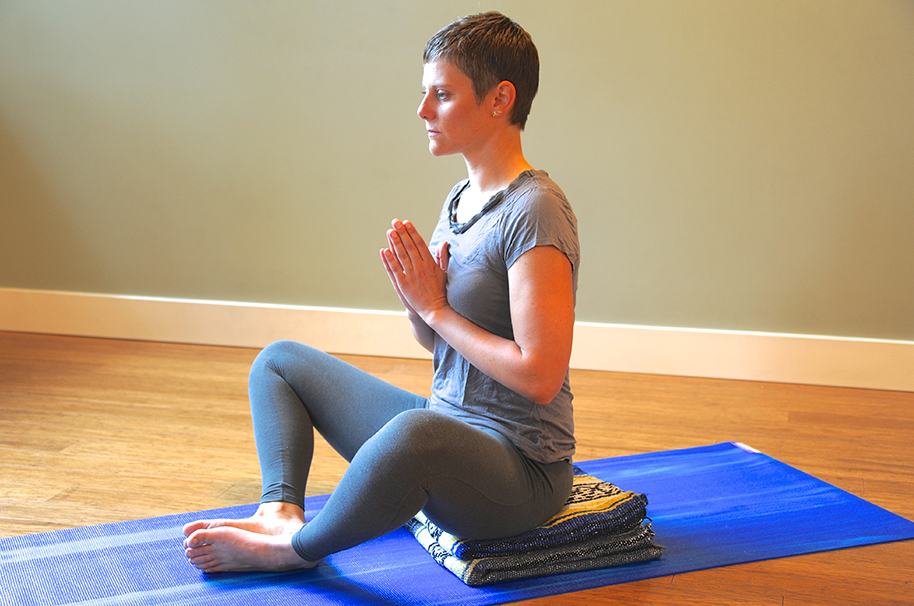
I like to sequence my asana classes in an arc. This means that we start slow, work up to more complicated poses, and then cool down to a long, luxurious Savasana. We practice one or more “peak” poses in the middle of the practice. When we think of the concept of a peak pose, we often think of extreme backbends and arm balances—poses that are unattainable for most people because of skeletal restrictions. In truth, some of the most humble, pedestrian-seeming poses—seated forward bends—are actually more challenging than they appear. Today, we’ll explore how to sequence a class to work toward Baddha Konasana (Bound Angle Pose) as a peak pose.
Baddha Konasana may look simple, but there’s actually a lot that needs to happen for the body to be able to practice it safely. First, you have to have a hip joint structure that allows for extreme external rotation and abduction. Stretching the obvious muscles—inner thighs, quadriceps, hips and hamstrings—is helpful, but for a person whose hip sockets are placed more anteriorly, and especially if those sockets are deep, no amount of flexibility will allow the knees to reach the floor.
So it’s important to understand that getting the knees to the floor is not the point. The point is to find a sense of ease and balance in whatever pose you’re practicing, no matter what it looks like. Still, there are ways to increase the ease, even if your hip joints are not made for external rotation.
If your knees are nowhere near the floor in this pose, it can be most helpful to focus on your spinal position instead of your thigh position. When the knees are higher than the anterior superior iliac spines (hip bones), it’s quite challenging to tilt the pelvis forward so that your spine can maintain its natural curves. If this is the case for you, sit on several folded yoga blankets, place your hands next to your hips and press down into your blankets to help tilt your pelvic rim forward. Unless you can bend forward by leading with the pelvis—not the waist—I wouldn’t recommend bending forward.
Here are the actions necessary for practicing a healthy Baddha Konasana:
- External rotation
- Abduction (thigh bone extends out from the center; this means that the adductors (inner thigh muscles) need to lengthen)
- Neutral spine (spinal curves are in their natural “S” shape)
Prep Poses for Baddha Konasana
In order to prepare the body for Baddha Konasana, we need to both warm and stretch the muscles that create these actions. Of course, there are lots of yoga poses that can be helpful. I offer some suggestions below, but it can be a fun exploration to consider poses in terms of these actions, and add your own ideas to the sequence. The links below contain detailed instructions for each pose listed.
- Prasarita Padottanasana (Wide-Legged Forward Bend Pose): I love starting with standing poses because they strengthen (warm) and stretch the leg muscles simultaneously. This particular pose focuses in on the inner thighs and hamstrings. When you practice, engage the inner thighs by drawing them up toward the hip joints.
- Virabhadrasana II (Warrior II Pose): Warrior poses are strong, warming poses. Warrior II, in particular, supports abduction in both legs and external rotation in the bent leg.
- Trikonasana (Triangle Pose): Like Warrior II, Trikonasana supports abduction and external rotation, but it also adds hamstring stretching to the mix.
- Ardha Chandrasana (Half Moon Pose): Ardha Chandrasana supports external rotation and abduction, and further stretches the hamstrings. It also warms the muscles of the standing leg.
- Utthita Hasta Padangusthasana (Extended Hand-to-Big-Toe Pose): If you look at this pose, you can see that it’s essentially the same shape as Ardha Chandrasana and Supta Padangusthasana, but with a different orientation to gravity. It further warms the muscles of the standing leg and supports abduction and external rotation.
- Ardha Virasana (Half Hero Pose): Now that you’ve warmed up your leg muscles, you can begin to focus on stretching. I like to start with the quadriceps. Of course, if your knee feels uncomfortable in this pose, please modify, or skip it. The quads should already be pretty warmed up after all the standing poses, so it’s okay to skip this if it’s problematic for your knees.
- Supta Padangusthasana (Reclining Hand-to-Big-Toe Pose): The first two variations of this pose (stretching the leg straight upward and stretching it out to the side), can help release the hamstrings and the adductors.
- Janu Sirsasana (Head-to-Knee Forward Bend Pose): In this pose, the bent knee is in Baddha Konasana position. It can be helpful to stretch the adductors one at a time in this position before attempting to stretch both simultaneously. Be sure to sit on plenty of support so that your pelvis can initiate the forward bend.
- Upavista Konasana (Seated Angle Pose): It should be obvious why this pose would be helpful for stretching the adductors. It also provides a bit more stretch for the hamstrings.
- Baddha Konasana (Bound Angle Pose): Finally! Time to practice the peak pose. Remember that getting the knees to the floor is not important. Instead, the most helpful action is to extend the inner thighs outward from the pelvis. As always, make sure you have enough support under your hips so that your spine can be straight.
- Paschimottanasana (Seated Forward Bend Pose): A relaxed Paschimottanasana will help you transition to an easeful Savasana.
If you are short on time, feel free to skip some of these poses. They’re all supporting of Baddha Konasana, but you don’t necessarily have to practice all of them to benefit.
If you want more information on hip-healthy practice, check out this book: Hip-Healthy Asana: The Yoga Practitioner’s Guide to Protecting the Hips and Avoiding SI Joint Pain.
